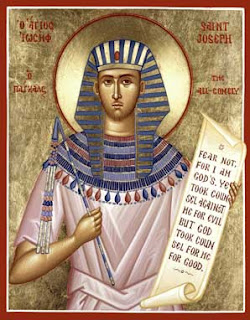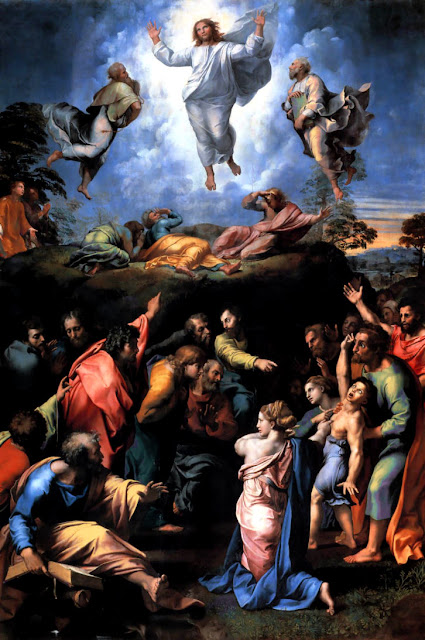And Joseph said unto his brethren, I am Joseph; doth my father yet live? And his brethren could not answer him; for they were troubled at his presence.And Joseph said unto his brethren, Come near to me, I pray you. And they came near. And he said, I am Joseph your brother, whom ye sold into Egypt.
Now therefore be not grieved, nor angry with yourselves, that ye sold me hither: for God did send me before you to preserve life. For these two years hath the famine been in the land: and yet there are five years, in the which there shall neither be earing nor harvest.
And God sent me before you to preserve you a posterity in the earth, and to save your lives by a great deliverance. So now it was not you that sent me hither, but God: and he hath made me a father to Pharaoh, and lord of all his house, and a ruler throughout all the land of Egypt. Gen. 45:1-8
 | ||||||
| Modern Icon |
 |
| Joseph's Coat. Ford Madox Brown, c. 1860 |
 |
| Joseph Being Sold into Slavery Károly Ferenczy, 1900 |
 |
| Jacob Receiving the Tunic of Joseph Diego Velazquez, c. 1630 |
Today I will just read Joseph's story out of Genesis; my kids are already familiar with it from Sunday School and story books.
After reading the story, they will study the paintings and they will decide which part of the story the artist depicted. One idea I have for commemorations of saints associated with a definite and familiar narrative (Moses, Jonah, Elijah, Noah), is to print out a bunch of paintings with different scenes from their stories (maybe mounting them on card stock so you can reuse them each year), and have early elementary kids put them in chronological order (after reading the story). I won't do that this year, but maybe in a year or two.
Since my kids are familiar with Joseph, I decided to try a little Luther commentary on them (not word-for-word, but paraphrase). I will try out a "game": how is Joseph a lot like Jesus? So after reading the following commentary (from Chapters 45 - 50, Luther, Martin; "Luther's Works", Vol. 8) to get myself in the right mindset, I came up with a list (and found some more comparisons online):
On Joseph's sufferings: "Therefore we [Christians] must be troubled and humbled, if not by bloodshed and imprisonment, as the saintly martyrs suffered, at least through spiritual trials, sorrow, grief, and anguish of heart. Otherwise we shall perish in our sins. For the flesh is corrupt, filled with poison, leprous, and has need of a physician to counteract that rottenness by means of cross, martyrdom, sadness, confusion, and disgrace. These, you see, are the medicines with which God purges away sin.
Holy Scripture is full of such examples. They show that the saints must endure. For when they are not subjected to trials, they forget their spiritual exercises. Then they pray, believe, and praise rather lazily. On the other hand, they cry out, groan, and complain when misfortunes come, and thus they are disciplined and instructed in the Word, as Isaiah says (Is. 28:19): 'Vexation gives understanding.'"
Joseph as a type of Christ: "Accordingly, I give this warning in order that we may not look at this manifestation of Joseph only in passing but may consider the great affection of the heart by which both Joseph and his brothers were benumbed. I would not know how I should have reacted when he said: 'I am Joseph.' Nor do they know. What will happen, then, when our Lord and Savior JESUS Christ comes, who also disciplines us in various ways in this life and allows us to be troubled, scourged, killed, etc.? What great joy there will be after that sudden and unexpected change, since we previously felt that He was a very harsh tyrant who wanted to destroy everyone in a trice! Then He will say: "I am Joseph; I am your Savior." I cannot explain this revelation of Joseph worthily; but it must be read and pondered often, . . ."
On the Secular Kingdom and those against the Church: "Thus today the emperor, the pope, and the Mohammedans live and remain in this world for no other reason than for the sake of the church, the Word, and the sacraments. When these have been removed, they will perish at once, as Daniel 12:7 testifies: 'When the shattering of the power of the holy people comes to an end, all these things would be accomplished.' But in the meantime states [governments] and the procreation and education of children remain, because the number of the elect has not yet been completed. Many of these have not yet been born. But when the number is completed, then let the pope and the Turk see what will become of them!
The church alone, however, preserves all things and is a nursery in the world by which the Word and the sacraments are propagated and retained. Proselytes are added to it every day. They hear and embrace the heavenly doctrine. In the meantime the pope, the emperor, and the Turk also rage against us and fight against the pillars that support and preserve them."
Luther on godly public servants: "Therefore Pharaoh did not receive a private individual, a man whose only concern was domestic or political. No, he received the church of God itself, which he cherishes, nourishes, and defends. This is an outstanding honor and regal dignity. Because of this he was deservedly called a most saintly and godly man, a man honored by God; for he was raised up by God for such an important function in order that he might preserve the church and give it a place, time, and protection, so that it could be gathered, multiplied, and built."
"Would that today, too, we had more princes like him! For this was an excellent and incomparable virtue in King Pharaoh-a virtue which deserves to be praised by all. And that he was filled with faith and the Holy Spirit is apparent from the fact that he supports the church with such great kindness and without recompense or any greed. For at the present time you could find many who profess the doctrine of the Gospel until they have plundered the parishes, the associations, and the monasteries. There are very few who befriend the teachers and pastors of the churches out of zeal for godliness and from the heart. But if there are such men, they do the right thing by following the example of Pharaoh; but it surely was scrupulous, saintly, and Christian to the highest degree. For Pharaoh has no regard for his private advantage and in supporting the church has no other consideration than piety and reverence for God. He himself seizes nothing. Indeed, he rather offers all his own property and lavishes it on the protection and support of the house of Jacob."
Jesus and Joseph
(I found this list at http://www.reclaimingwalther.org/articles/jmc00294.htm)
1. Joseph's brothers were bewildered by his visions of his great authority while Christ's disciples never understood the prophecies of His death and resurrection.
2. Joseph and Jesus were both betrayed and sold; Joseph for 20 pieces of silver and Christ for 30 pieces of silver.
3. Joseph's coat was dipped in goat's blood; Christ's robe was covered with his own blood.
4. Joseph was thrown into a pit while Christ was placed in a tomb.
5. Joseph's father was told Joseph was dead while was Christ killed by the will of both man and God.
6. While in room by themselves Joseph's eleven brothers discover he is alive. While in a room by themselves Christ's eleven disciples discover has risen from the dead.
7. Joseph saves his brothers from starvation while Christ saves all His brothers and sisters from sin.
8. Joseph brings his brothers to repentance while Christ removes sin from us.
9. Joseph absolves his brothers while Christ pays for our sin.
10. Joseph has bread for everyone who comes Egypt while Christ is the bread of life for the whole world.
11. Joseph leads all Egypt to be owned by Pharaoh while Christ has purchased the entire world and places it under God the Father.
12. God sends Joseph to preserve life while Christ gives us eternal life.
13. Joseph saves the church in Egypt while Christ saves the Church in heaven.
14. Joseph announces that God used Him for great deliverance while Christ has delivered us from sin, death, and hell and given us eternal life.
15. God used Joseph's evil brothers to make Joseph the ruler of Egypt as He used the evil Chief Priests, Scribes, and Pharisees to make Jesus Lord of Lords and King of Kings.



































